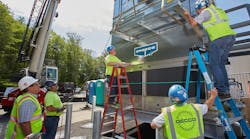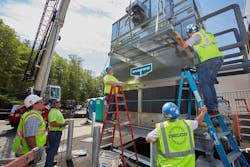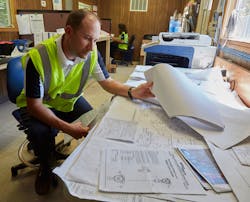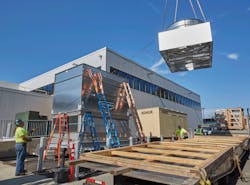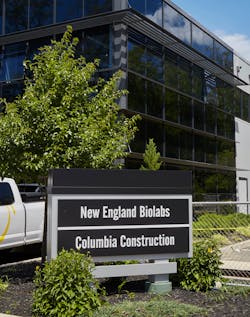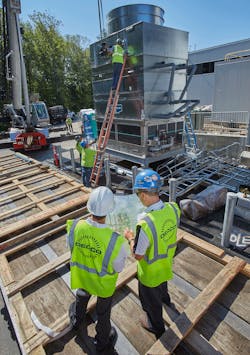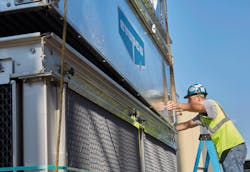Process Cooling System Saves Both Water, Energy at New England BioLabs
By DANIELA LLANOS, P.E., and JOHN VASTYAN
Behind the scenes of the most cutting-edge genetic science lies the work and expertise of companies like New England BioLabs, Inc. (NEB) based in Ipswich, MA.
Since the 1970s, NEB has provided enzymes for use in molecular biology research and clinical trials, serving a network of customers internationally.
The enzymes produced at NEB are used in applications like cloning, DNA modification and protein analysis – applications which are highly precise, requiring components that are predictable, repeatable and of the highest quality.
To better serve the ever evolving needs of their customers, NEB has recently completed the construction of a 40,000-sq-ft cleanroom production facility in Rowley, MA.
Assembling the Right Team
Pulling it all together was the project management firm, Columbia Construction Company, a Boston-based company with over 90 years experience in multiple sectors: academic, life sciences, corporate, healthcare and hospitality.
Columbia Project Manager Neal Swain explained, “We were involved with the construction of NEB’s new facility for the entire process, from design review to final commissioning.”
Columbia worked with AHA Consulting Engineers on the building’s engineering infrastructure, including the plant’s process cooling mechanical system. AHA’s clients include companies such as Vertex, Takeda, Merck, and NEB itself, as AHA served as the design engineers for its main facility.
As is customary in the industry, AHA worked with suppliers to find the right equipment to meet NEB’s specific requirements. Manufacturer’s rep firm, Fluid Equipment Solutions of New England (FES), provided technical assistance for the cooling system at this new facility.
Tight Tolerances for Cooling
Accurate and robust temperature control of the equipment and environment is critical to the success of the tightly controlled manufacturing processes.
A key component of the cooling system that meets the stringent cooling needs at NEB’s facility is its fluid cooler, a 1.6 million BT0U closed circuit cooling tower designed to provide cooling to process water for a wide variety of sophisticated plant processes.
“The fluid cooler provides condenser water to one side of a heat exchanger,” said Thomas Joyner, partner, and AHA project manager. “The process water on the other side of the heat exchanger serves several pieces of plant equipment as well as a process chiller to provide chilled water for manufacturing.”
For such a large, yet critical piece of the cooling puzzle, AHA considered several options for the fluid cooler. With the rising cost of energy and concern about water consumption, the amount of electricity and water used was an additional factor in deciding which cooling system to specify.
Ben McLaughlin, sales engineer at FES said, “We compared the performance of multiple evaporative fluid coolers in terms of meeting the required temperature as well as energy and water use.”
After careful analysis, EVAPCO’s eco-ATWB-H series hybrid fluid cooler was selected. The system is specifically designed to optimize both the evaporative (latent) and dry (sensible) modes of cooling simultaneously – combining the advantages of an evaporative cooler and a dry cooler into one unit.
A Balancing Act
McLaughlin explained, “There were three aspects of the fluid cooling system that were critical for this application. The first was the cooling tower’s wet and dry performance.”
The hybrid fluid cooler has both wet and dry operation with the ability to handle full capacity in “dry mode” up to an ambient dry bulb temperature of 50oF. This reduces water consumption for every hour of operation below 50o when the water is turned off and the fan alone is doing all the cooling.
“In addition to water savings, the five-horsepower spray pump is turned off during dry cooling and that results in energy savings when compared to the standard fluid cooler using evaporative cooling only,” said McLaughlin. “So we have about 60% less water used and a 30% reduction in electricity consumption.”
Process water first enters the dry coil which is outside the evaporative water spray stream. This coil serves to pre-cool the high temperature water. The cooled water then enters the coil, just below the spray stream. Depending on the dry bulb temperature, the spray pump may be on or off.
A key benefit of the dry coil, piped in series with the wet coil, is that the evaporation rate off of the wet coil is maximized because a significant portion of the heat load from the process has already been rejected by the dry coil before entering the wet coil. This means that water is always saved, even when spray pumps are required for full load.
The additional dry coil also allows for reduced water vapor leaving the cooling tower, which happens because of efficient transfer of heat from the process water to the moist air leaving the cooling tower. Increasing the temperature of the air leaving the tower, without adding moisture, reduces its relative humidity from a saturated state (at 100%), which greatly reduces the visible plume.
In order to get the most out of this hybrid system, the fan and spray pump operation are controlled to maximize savings. The control system provided with the cooler plays a key role in optimizing water and energy savings.
“The controller leverages outdoor or ambient conditions,” explained McLaughlin. “Specifically, the wet bulb and dry bulb temperatures are used to best meet load requirements while reducing water and energy consumption. This sophisticated operation is handled in stride by the SAGE control system.”
This tight control is what gives NEB the level of utility savings as well as the consistency and predictability needed for their manufacturing processes.
Eco-friendly Accessories
The other key evaporative cooling system components are the water treatment, and the quiet fan, also selected by the design team. Although water treatment is necessary to maintain evaporative cooled equipment during wet operation, a substantial benefit to a primarily dry cooler is that scale cannot form when the unit is operating in dry operation.
To prevent scale buildup or corrosion from deposits when water is evaporated in the cooler, the water must be treated. In order to maintain an environmentally friendly manufacturing facility, a non-chemical treatment system was provided for this evaporative water.
“We included the Pulse-Pure® non-chemical water treatment system with the fluid cooler,” McLaughlin explained. “This system uses a high frequency electromagnetic pulse to take care of the corrosive or scale-forming solids that would otherwise concentrate on the cooler’s components when water evaporates. It also takes care of anything biological that we’re usually concerned with because it renders microorganisms incapable of reproduction.
In addition to reducing chemicals used on site, the unit itself produces less sound pollution. The super low sound fan selected boasts a 9 dB to 16 dB reduction in sound when compared to the standard fluid cooler fan.
“The reduction in sound is concentrated in the low-frequency octave band, which travel further distances and penetrate structures,” explained McLaughlin, “so these are the fans specifically designed for applications that are sound-sensitive in nature.”
With EVAPCO’s hybrid fluid cooler serving the manufacturing process, New England BioLabs’ new cleanroom production facility achieves both high quality product and lower water and energy consumption.
“We took the shell of a building and turned it into a 40,000-sq-ft cleanroom production facility,” said Swain, “and the process cooling system assures utility savings while delivering predictable outcomes for NEB’s customers, both existing and those we expect to serve in the future.”







